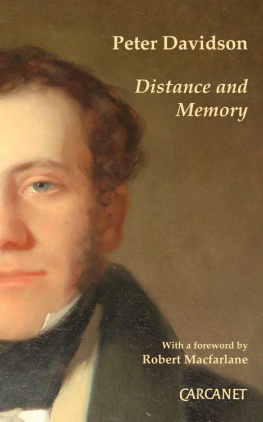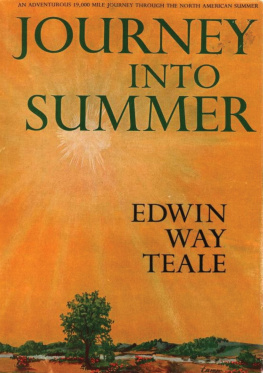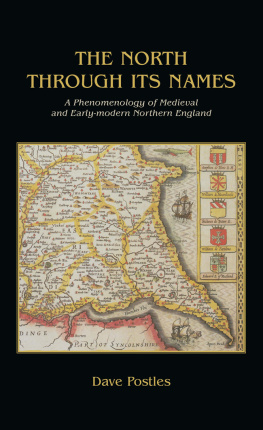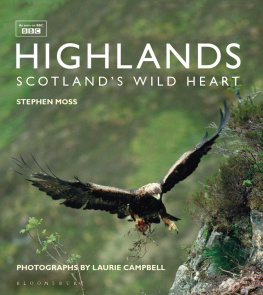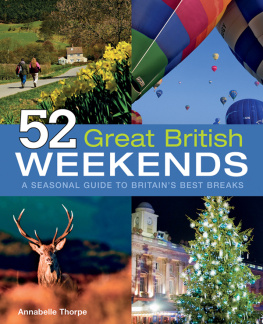In the lucid air of certain regions of the far north, light is able to move through the atmosphere unhindered by particles of dust or pollution. The photons proceed without being scattered save by the molecules of air itself and the optical consequence is that faraway objects appear close at hand. The lichen patterns on a boulder may be discerned from several hundred yards; a seal basking on a floe seems within reach of touch. In such places, under such circumstances, telescopy occurs, such that in a seeming paradox distance makes possible miracles of scrutiny, and remoteness becomes a form of clarification.
Peter Davidsons prose enables a similar phenomenon. Again and again, in the pages that follow, looking from afar from future to past, from exile to homeland, from mountaintop down at lowlands, from island back at mainland results not in visions diffusion, but in its sharpening. Distance, here, throughout, is reconfigured as proximity.
Peter lives in what he calls a removed and exceptional part of Scotland: the wedge of land that is bounded to its south by the mountains of the Cairngorms, to its north by the waters of the Moray Firth, and which stretches eastwards to meet the North Sea between Aberdeen and Peterhead. A few miles from his house rises the five-toothed peak of Bennachie, on the slopes of which Agricolas auxiliaries fought and defeated the Caledonians the northernmost Roman action during the centuries of occupation. Further west are the Ruthven Barracks, that lonely outpost (a Camp Bastion of its day) built by Hanoverian soldiers after the Jacobite rising of 1715. His latitude is a frontier latitude, then: around and beyond him issue the true northlands, whose cultures and landscapes have inspired his poetry, essays, scholarship and dreams for more than thirty years.
It is an exceptional part of Scotland in that it has excepted itself from many of the conventions of British history and geography. Beaker inhumation, as Peter points out, is thought to have been practised there for two centuries longer than anywhere else in Europe. Catholicism thrived and simmered there after the Reformation; loyalty to the House of Stuart persisted after the Revolution of 1688. A dissident region, then: not renegade, exactly, but fond of being able to mind its own business. A territory of shadows, secrets, sequesterments, discretion and absence. Like the landscape out of which they chiefly arise, these essays are bound together by a tight matrix of qualities (reticence, allusiveness, unshowiness); by a repertoire of tones (elegiac, desirous, heterodox); by a cluster of repeating tropes (shadows, gleams, light-fall, ice, cusps, thresholds); and by a palette of colours (the green-gold of summer, the silvers and blues of winter, the bronzes of autumn). Peter writes, we might say, in a northern vernacular, exactly responsive to its region, in which the specifics of terrain and weather are internalised as a kind of grammar. It is a style fine in its granulation, subtle in its shading, and stricken throughout by a gentle melancholy.
One of the consistent marvels of these essays is the attentiveness to place they exhibit. Insofar as remoteness brings undisturbedness, it encourages observance both in the devotional sense of regular habits adhered to, and in the phenological sense of recording natural details. Distance and Memory is structured seasonally, so that to read the book from start to end is to experience a years turn of atmospheres and fluxing light. Paragraph after paragraph practises a kind of bejewelled notation, born of long acquaintance and repeated seeing: in May there is a pencil-stripe of light beyond the pine trees on the northern horizon, the reflection of the brightness over Sutherland, relentless daylight over Norway; a June evening brings green silence; on October afternoons bright kingdoms open in the Cairngorms; brilliant depths of the frost and the returning cold signal winters ascent. Such observations may seem like jottings, but on examination they turn out to be images of intricate facetting. Of a lake-shore in Scandinavia: A little stone jetty in still water: water like pewter, extraordinary water. The extreme stillness of the sentence is in part a function of its verblessness, but is due also to the reflection of water within itself (water: water), an effect doubled again as the word pewter catches and returns with just a ripple the word water. Peter writes in the course of this book of numerous artists and writers Frances Walker, Cosmo Alexander and Eric Ravilious among them whom he admires: he shares with them all a technical ability to caress the familiar into uncommon lustre, and to catch at the fleeting and strange.
Ravilious noticed everything, writes Peter appreciatively; the same might be said of him. Ravilious saw the gradations of rust and soot on a tar-engine put away for the winter. Peter notices the [f]ine gradations that mark this turn of the year to spring: the glass of the lake rising a little with the snow melt; steel drifts of ice on water like mercury. The first wood-anemones on the scrubbed table which runs the length of the room. The rising glass of the lake suggests first a thermometric change, the temperature-creep of the coming spring; but it is also and firstmost glass as water-surface, rising in level as the snowmelt joins the winter water. Mercury draws us back into the thermometer, but is at once an image of the ices hard silver gleam. The intricacy of language here is a version of the intricacy of the handover of winter to spring overlapped and shifting. Such careful slivering-out (the ability to discriminate without finicking) is one of the signatures of Peters style and sensibility. It results in a lyricism delicate in its structures as an ash-frail.
There is, unmistakably, a curatorial impulse to this fascination with the observed instant. Peters prose aspires, as he puts it, to capture the moment, lost and yet preserved forever. His sentences devote themselves to the record of volatile subjects (textures of weather, tones of colour, a fall of light which dies even as the hand attempts to catch its likeness), and they do so in foreknowledge of the failure of their task. Two words recur dozens of times in the course of Distance and Memory: stillness and fugacity. The relationship between the fixed and the fugitive is at the books intellectual core, and at the source of its melancholy. Each of Peters sentences acts as what Thomas Browne in Urne Burialle his great 1658 meditation on corruption, pristination and retrieval beautifully calls a conservatorie. Yet none of these conservatories is quite reliable, none fully sealed. All leak a little light. All are vulnerable to what Peter piercingly calls the predatory loss that shadows all human pleasure. Walking the coast of Arctic Finland,
[we] came suddenly onto basalt rocks bordering the Baltic, with the dazzling track of the sun coming straight through the sandbar which sheltered the bay. A young man was swimming there, quietly and alone, swimming breaststroke with barely a ripple until he moved out of the shadowed waters and his tow-fair head vanished in an instant into the brilliance of the high sun on the sea.
Here, the completion of the scene is also its annihilation: the swimmer cannot stay still, however tranquil his motion, and must move on from the shadows and into the irradiating high sun, which both illuminates and disappears him.
The unit of this book, then, is the lyric image (devoted to preservation but conscious of perishability); its larger structure might be understood as a kind of Wunderkammer, seeking vainly to gather and organise extraordinary artefacts. When I first visited Peter at his high-halled, white-walled, hunkered-down house in the fold of valley at Turriff, he took me up to a south-facing room thick with summer light, and there opened the two pale-blue wooden doors of the cabinet of curiosities that he had made there, and explained to me the origins of the objects he had gathered to fill it. For the individual compartments of the cabinet held remarkable things, among them the round black mirror of an eighteenth-century Claude glass; a little dog modelled in unfired clay, Babylonian in origin, impossibly old; a sixteenth-century armourers trial piece of a long face framed by a helmet in the form of a wolfs head with open jaws (a disquieting image of man-wolf or wolf-man); an engraved brass box of seventeenth-century Low Countries manufacture, which once held one of the straws on which fell drops of the blood of the Jesuit Henry Garnet, executed in London on 3rd May 1606, bloodstains which were said to have formed a likeness of his face; a slice of marble from a quarry near Bristol, in which the veinery had by geological chance formed into a perfect facsimile of a sad Victorian landscape of misty ploughlands at evening Yes, Peters preoccupation with

